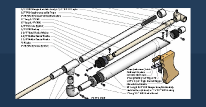
INTRODUCTION
I was annoyed by the moving arms that were present in the NEAR, and did not like
the magazine on the top; a byproduct of the failed tube magazine. As such, I
designed a new gun, using some ideas of my own and some of Boltsniper's, to
create this gun. The goal was to have a long-range gun while keeping it
managable in size. While the range was less than I had expected for having a
massive length of pull of almost over 5", I guess anything over 100' is overkill
in nerf anyways, so I settled with what I had and decided not to go in and do
any serious changes after the first range tests.
SPECIFICATIONS
Description..................Carbine Rifle
Release Date.....................8/22/2006
Caliber..............0.54" (Micro Stefans)
Operation......................Pump-Action
Propulsion..................Spring Plunger
Magazine............Detachable Bottom Feed
Mag Capacity...............8 Micro Stefans
Overall Length.......................28 in
Barrel Length........................14 in
Max Rate of Fire....................60 RPM
Max Range...........................100 ft
Effective Range......................80 ft
Intended Use.......................Primary
DESIGN
IWhen I designed the rifle, I wanted as few moving parts on the outisde of the receiver as possible. As such, I
enclosed everything in a larger-sized pvc than I normally used, which resulted in a receiver body of 1-1/4" pvc. The bolt I had been using in previous guns has always led to a significant amount of air loss; while I had sufficient plunger volume in the previous guns to overcome this air loss, it still bugged me, and took up precious length. As such, I decided to make the jump to the brass bolt that is used on Boltsniper's BS-9, and my MEG pistol. The Magazine itself still uses a simple paperclip to hold the rounds in when not loaded into the gun, but it's a method that works remarkably well. The addition made to the clip is a small spring-loaded lever that attaches it to the bottom of the gun. Previously I had to just rely in friction to get the clip to stay in place. That is now changed, because I decided to get off my lazy ass (laziness being the reason this wasn't done before) and actually make a clip-holding mechanism.The gun itself came out to 28" long. While I had originally planned it to be 26", the additional 2" came from the rear-end of the stock and a small protrusion of the coupler from the front end of the gun, which I had not accounted for
in the original design. Another feat of Boltsniper was his genius trigger design. I made good use of it, and found that it was remarkably easy to make using nothing but a dremel, sandpaper, and a hacksaw. It works great, is easy to maintain, and easy to replace. The magazine is now made of plexiglass and PVC, since balsa just plain sucks for anything that is to be handled roughly.
MATERIALS
PVC and plexiglass is used for pretty much everything:
-1 1/4" SCH 40 PVC
-1" 200 psi PVC
-1" SCH40 PVC Endcaps & Couplers
-1/2" PVC Endcaps & Couplers
-1/2" SCH80 PVC
-1/2" CPVC
-1/2" SCH40 PVC
-O-Rings of Various Sizes (whatever fits best for your batch of PVC)
-Aluminum washer with the same outer diameter as 1/2" SCH40 PVC
-1/8" Plexiglass sheeting
-Music wire of whatever thickness you choose
-Screws galore (varying length, dependent on how deep the screws must go)
COMPONENT DETAIL


BARREL AND BOLT

The construction of this part of the gun is probably the most important; there is not much tolerence to work with, and if this part is not strong, then the force of the plunger hitting this area will cause this part of the gun to shatter. As such, there are a total of 3 metal washers and a whole lot of superglue. Basically, the barrel and breech opening are one. The SCH80 pvc I used was able to fit 9/16" brass in it. As such, the breech opening itself is made of 17/32" brass, with a hole cut to fit my darts in it. Attached to this piece, and nested in the barrel itself, is the 9/16" brass. This means that around the 17/32" brass that is the breech, there is a space that 9/16" brass can fit perfectly into. That would be the piece in the part pictured below. The barrel itself remains stationary; you can see the screw holes in the top piece where it screws into the receiver. The Bottom piece is basically a long piece of 1" thin-walled PVC with some filler at the bottom, 2 washers (one in back which
is visible, and another on the inside, that makes contact with the other washer on the rear end of the barrel, which is also visible), an o-ring, and the brass bolt. In short, the bottom piece moves back and forth, and the brass that is a part of the moving piece will uncover/cover the breech as it moves back and forth. The o-ring on the bottom part is there to form a seal with the receiver, as the plunger hits where that foam padding is. If you don't have a seal there, the air will all escape around the moving part. The pump is attached to the moving part (not quite sure what to call it to be honest) via some screws.
PLUNGER


I cannot describe how much time went into this thing. It wasn't even taken up meticulously cutting, but sanding away the inside of that damned washer to make it fit. The reason the plunger head is so big is to ensure that the back piece moves straight back centered; when the plunger is pushed back, the back piece must engage with the catch pin, which involves it fitting through a hole just a little larger than the catch face itself. At each joint, there is music wire that is pushed through a hole in order to strengthen everything. The beveled end
to the plunger allows the plunger to push down the catch pin when it gets to it. The catch pin then goes back up after the catch face, and the rest is common sense. This shortened plunger is what allowed the gun to be 28" long yet have a plunger tube length of around 5+".
Trigger, Catch, and t3h Lower Receiver



This part really is self-explanatory. The trigger plate is made out of aluminum, and it pushes the catch pin (which is not in the pictures) up and down. It's basically the same system that is used in the SCAR-N, the GNS, and the BS-9 (all Boltsniper's). The trigger itself is made of 2 pieces of plexiglass bonded together. It is one in the picture, but it's two as of right now. Trust me, if you use one it'll snap, and it'll suck. The handle. Oh what a bitch this can be. If you just use epoxy or superglue to bond it on (unless you're really good with the stuff; I have terrible luck however, even after I properly sand the surfaces and everything), it tends to fall off easily. As such, I just filled half of my handle with Bondo, and put some screws straight down into it after the Bondo dried. That handle isn't coming off any time soon.
Stock

That's the stock. You can pull it off in case you need to check the condition of the plunger without taking the whole gun apart. The holes are there because the plunger gets such a good seal with the receiver, that when you fire it a vacuum actually sucks air from the back, and without the holes the plunger is slowed significantly.
Construction
This thing is less complicated than pretty much any of Boltsniper's weapons. I mean, you pretty much put it together the only way it would be able to go together. You start with the upper receiver, you stick the main spring in, then the plunger, then the part that moves, then the barrel, you screw in the barrel, then stick on the lower receiver. Done.
I'll get videos up later; transferring all this info to an NH post has taken it out of me.
Oh, and I'd like to say this is property of NH and Boltsniper.com (if I can get the template back to normal).
~ompa
























